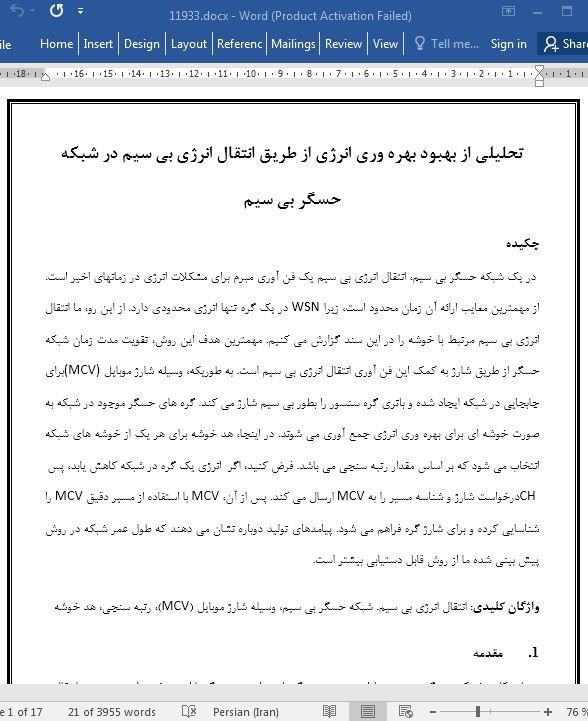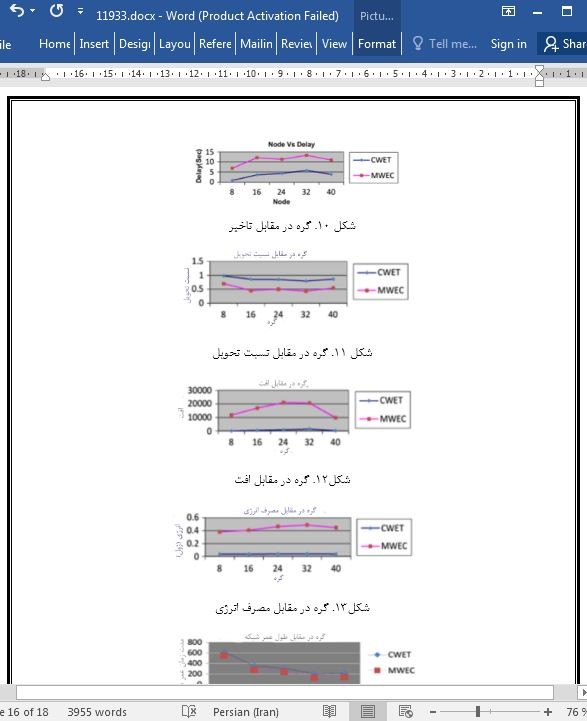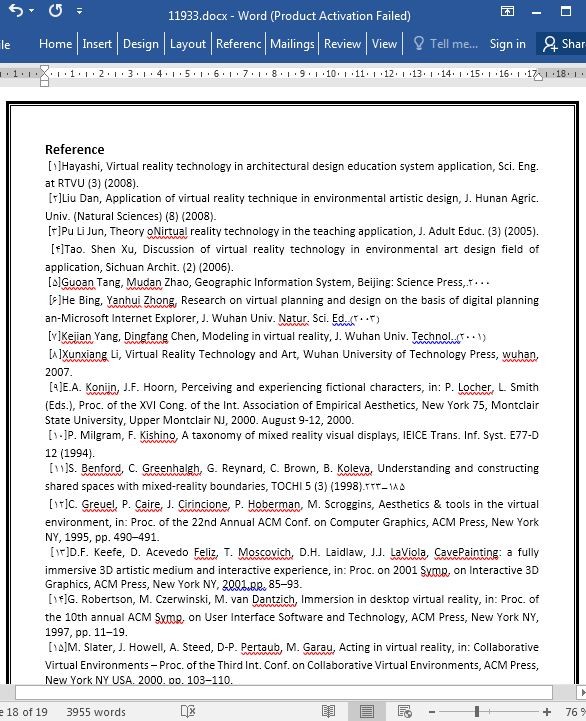
تحلیلی از بهبود بهره وری انرژی از طریق انتقال انرژی بی سیم در شبکه حسگر بی سیم
چکیده
در یک شبکه حسگر بی سیم، انتقال انرژی بی سیم یک فن آوری مبرم برای مشکلات انرژی در زمانهای اخیر است. از مهمترین معایب ارائه آن زمان محدود است، زیرا WSN در یک گره تنها انرژی محدودی دارد. از این رو، ما انتقال انرژی بی سیم مرتبط با خوشه را در این سند گزارش می کنیم. مهمترین هدف این روش، تقویت مدت زمان شبکه حسگر از طریق شارژ به کمک این فن آوری انتقال انرژی بی سیم است. به طوریکه، وسیله شارژ موبایل (MCV)برای جابجایی در شبکه ایجاد شده و باتری گره سنسور را بطور بی سیم شارژ می کند. گره های حسگر موجود در شبکه به صورت خوشه ای برای بهره وری انرژی جمع آوری می شوند. در اینجا، هد خوشه برای هر یک از خوشه های شبکه انتخاب می شود که بر اساس مقدار رتبه سنجی می باشد. فرض کنید، اگر انرژی یک گره در شبکه کاهش یابد، پس CH درخواست شارژ و شناسه مسیر را به MCV ارسال می کند. پس از آن، MCV با استفاده از مسیر دقیق MCV را شناسایی کرده و برای شارژ گره فراهم می شود. پیامدهای تولید دوباره نشان می دهند که طول عمر شبکه در روش پیش بینی شده ما از روش قابل دستیابی بیشتر است.
1. مقدمه
به طور کلی، شبکه حسگر بی سیم دارای چندین حسگر باتری است. حسگرها انرژی خود را در سنجش، انتقال و دریافت جابجا می کنند. از شارژ باتری نیز در شرایط افزونگی درست استفاده نمی شود. در شبکه حسگر بی سیم، این روند مبرم برای تقویت بهره وری انرژی گره در زمانهای اخیر می باشد. هنگامیکه این گره ها با استفاده از یک باتری موتوریزه می شوند، تنها مدت زمان محدودی دارند. اگر مرحله باتری در گره های حسگر محدود باشد، پس افزایش بهره وری انرژی بهترین مقابله برای آن است. در روند ارسال، حسگرها انرژی خود را جابجا می کنند. اخیراً، حسگرها در همه زمینه ها به ویژه در زمینه مراقبت های بهداشتی، مهمترین نقش را ایفا می کنند (1). پیش از این، محققان متعددی برای افزایش مدت زمان شبکه حسگر تلاشهایی را انجام داده اند (2-4).
5. نتیجه گیری
در این مقاله، انتقال انرژی بی سیم مرتبط با خوشه را مطرح کردیم و روش ما با استفاده از شبیه ساز شبکه NS2 تکرار می شود. در اینجا ، حسگرهای شبکه به صورت یک خوشه جمع می شوند و هد خوشه برای هر خوشه با کمک مقدار رتبه سنجی وزنی انتخاب می شود. از انتخاب گره در بین کمترین تعداد هاپها برای انجام مسیر یابی استفاده می شود. فرض کنید که اگر انرژی گره در خوشه کاهش یابد، پس از آن هد خوشه درخواست شارژ را برای متهم کردن گره به MCV ارسال می کند. نتایج شبیه سازی ما در خصوص طول عمر شبکه در روش پیش بینی شدۀ ما نشان داده شده است.
Abstract
In a wireless sensor network, wireless Energy transfer is a demanding technology for the energy difficulties in recent times. The foremost disadvantage of presentation is limited duration because WSN contains only restricted battery energy at a node. Therefore, we anticipated cluster-related wireless energy transfer in this document. The foremost intention of the method is to augment the duration of the sensor network through charging by the help of this wireless power transfer technology. So that, mobile charging vehicle (MCV) is established to move within the network and charge the sensor node battery wireless. The sensor nodes in the network are collected as a cluster for energy efficiency. Here, the cluster head is chosen for each one cluster in the network which is based on the rank metric value. Suppose, if one node in the network is reducing its energy, then the CH will send charge request and route ID to the MCV. Afterward, the MCV recognize the node by means of the exacting route and establish to charge the node. The reproduction consequences illustrate that the network lifetime of our anticipated method is enhanced than obtainable method.
1 Introduction
Generally, the wireless sensor network contains several battery sensors. Sensors misplace its energy on sensing, conveying and receiving. The battery charge will also misplace in redundant condition. In wireless sensor network, the demanding procedure is to augment the energy efficiency of the node in recent times. When the nodes are motorized by means of a battery, then it contains only restricted duration. If the battery stage of sensor nodes is restricted, then the energy-effectiveness enhancement is a foremost confront. In the process of sending, the sensors misplace their energy. Recently, the sensor performs a foremost function in all areas particularly in health care observation [1]. Previously, several researchers put their attempt to extend the duration of sensor network [2–4].
5 Conclusion
In this document, we proposed cluster-related wireless energy transfer and our method are replicated by means of the network simulator NS2. Here, the sensors of the network are gathered as a cluster and the cluster head for every cluster is preferred by the help of rankrelated weight metrics value. The choice of the node among a least hop count is used to take place the routing. Suppose, if a node in the cluster is exhausted its energy, then the cluster head sends the charge request to the MCV for to accuse the node. Our simulation consequences are illustrated about the network lifetime of our anticipated method.
چکیده
1. مقدمه
2. کارهای مرتبط
3. انتقال انرژی بی سیم مبتنی بر خوشه در WSN
3.1. بررسی اجمالی
3.2. مدل سیستم
3.3. تشکیل خوشه
3.4. انتقال انرژی بی سیم
4. نتایج و بحث
4.1. عملکرد مبتنی بر گره ها
5. نتیجه گیری
منابع
Abstract
1. Introduction
2. Related work
3 Cluster-Based Wireless Energy Transfer in WSN
3.1 Overview
3.2 System Model
3.3 Cluster Formation
3.4 Wireless Energy Transfer
4 Results and Discussions
4.1 Performance-Based on Nodes
5 Conclusion
References
- ترجمه فارسی مقاله با فرمت ورد (word) با قابلیت ویرایش، بدون آرم سایت ای ترجمه
- ترجمه فارسی مقاله با فرمت pdf، بدون آرم سایت ای ترجمه



